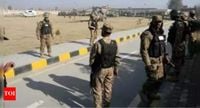In a series of violent incidents that have rocked Pakistan’s restive regions, security forces and civilians alike have suffered heavy casualties amid a surge in insurgent attacks. The last days of September and the dawn of October 2025 brought a wave of bombings, gunfights, and deadly confrontations, painting a stark portrait of the ongoing instability in Balochistan and Khyber Pakhtunkhwa provinces.
According to reports from PTI and Dawn, the bloodshed began on September 30, 2025, in South Waziristan, a district in Khyber Pakhtunkhwa. In the village of Ashangi Lagad, five villagers were killed instantly after coming into contact with a bomb-like object left on the road. The explosion, described as powerful and sudden, sparked panic among local residents, who have since called for authorities to ramp up efforts to clear unexploded ordnance and safeguard civilian life. Security forces and local administration officials responded quickly, launching an investigation at the site of the blast. The sense of fear and urgency in the aftermath was palpable, with many in the community expressing frustration and grief.
Just hours after the Ashangi Lagad tragedy, violence struck again in the Wacha Khawora area of Wana, also in South Waziristan. Here, four militants met their end when an improvised explosive device (IED) they were attempting to plant detonated prematurely. Among the dead were a local militant commander, Yar Muhammad Muslim, and Zameed Alam of the Ashangi tribe, as well as two unidentified associates. The incident underscored the ever-present dangers not only for civilians but for militants themselves, whose deadly tools often backfire with fatal consequences.
Meanwhile, in Quetta, the capital of Balochistan, the violence reached a horrifying crescendo. On the same day as the South Waziristan bombings, a powerful car bomb exploded outside the paramilitary headquarters near the Frontier Constabulary (FC) headquarters. The blast, which was reportedly heard miles away, killed at least ten people, including four security personnel, and left several others wounded. Ambulances rushed to the scene, ferrying the injured to local hospitals as chaos and confusion reigned. Muhammad Baloch, the Senior Superintendent of Police (SSP) for special operations in Quetta, told Dawn, “The blast occurred as an explosive-laden vehicle took a turn from Model Town towards Hali Road, near the Frontier Constabulary (FC) headquarters.”
This devastating attack came on the heels of another suicide bombing earlier in the month. On September 3, 2025, a suicide attack at a political rally in Quetta claimed the lives of 11 people and injured more than 40. The explosion took place in a stadium car park, where hundreds of supporters of the Balochistan National Party (BNP) had gathered. The frequency and scale of these attacks have left residents and officials deeply unsettled, with many questioning how long the cycle of violence can continue unchecked.
Just one day after the car bombing outside the FC headquarters, Quetta was once again the scene of deadly conflict. On October 1, 2025, an operation was launched by the Counter-Terrorism Department (CTD) in the city’s Aghbarg area, following an intelligence tip-off. As the CTD team moved into position, they came under sudden attack by militants. In the ensuing exchange of gunfire, the CTD retaliated with force, killing ten terrorists on the spot. According to the CTD spokesperson, “Upon reaching the area, they were attacked by the terrorists but promptly retaliated.”
Heavy ammunition and weapons were recovered from the slain militants, who, according to officials, belonged to a banned outfit and had previously been involved in attacks on security forces. The bodies of the militants were shifted to a hospital for identification, as the authorities had not yet released their names. “Further investigation into the matter is underway,” the spokesperson added, underscoring the ongoing nature of the threat and the complexity of rooting out insurgent cells in the region.
These recent incidents are not isolated. Balochistan, in particular, has witnessed a marked deterioration in its security situation in recent months. Insurgents have intensified both the scale and frequency of their attacks, adopting increasingly deadly tactics. The banned Balochistan Liberation Army (BLA) has been at the forefront of this escalation, shifting its focus to inflict higher casualties and directly target Pakistani security forces. According to Dawn, the BLA’s new tactics have included suicide bombings, car bombs, and coordinated assaults on military and police installations—methods designed to maximize both physical and psychological impact.
The surge in violence has sparked a wave of concern across Pakistan’s political and security establishment. Officials have repeatedly emphasized the need for enhanced intelligence gathering, better coordination between agencies, and a renewed focus on protecting civilians in conflict zones. Yet, the challenge is daunting. The rugged terrain of Balochistan and Khyber Pakhtunkhwa, coupled with porous borders and longstanding grievances among local populations, has made it difficult to stamp out militancy entirely. Many residents feel caught in the crossfire, their lives upended by forces beyond their control.
For the families of those killed in Ashangi Lagad, Wacha Khawora, and Quetta, the grief is raw and immediate. The loss of loved ones—whether civilians, security personnel, or even militants—leaves scars that will not heal quickly. Local leaders have called for greater government support for victims and their families, as well as long-term strategies to address the root causes of insurgency, such as poverty, lack of education, and political marginalization.
As investigations continue into the latest attacks, the mood in Balochistan and Khyber Pakhtunkhwa remains tense. Security forces have vowed to press on with their operations, determined to dismantle militant networks and restore a semblance of normalcy. But with each new incident, the sense of vulnerability grows, and the question on everyone’s mind is whether peace can ever truly return to these troubled regions.
With violence showing no sign of abating, the people of Balochistan and Khyber Pakhtunkhwa face an uncertain future, their resilience tested yet again by forces that seem, at times, beyond anyone’s control.
